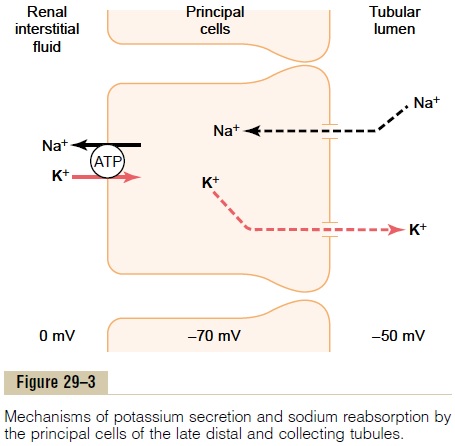Chapter: Medical Physiology: Renal Regulation of Potassium, Calcium, Phosphate, and Magnesium; Integration of Renal Mechanisms for Control of Blood Volume and Extracellular Fluid Volume
Potassium Secretion by Principal Cells of Late Distal and Cortical Collecting Tubules

Potassium Secretion by Principal Cells of Late Distal and Cortical Collecting Tubules
The cells in the late distal and cortical collecting tubules that secrete potassium are called principal cells

Figure 29–3 shows the basic cellular mechanisms of potassium secretion by the principal cells.
Secretion of potassium from the blood into the tubular lumen is a two-step process, beginning with uptake from the interstitium into the cell by the sodium-potassium ATPase pump in the basolateral membrane of the cell; this pump moves sodium out of the cell into the interstitium and at the same time moves potassium to the interior of the cell. The second step of the process is passive diffusion of potassium from the interior of the cell into the tubular fluid. The sodium-potassium ATPase pump creates a high intra-cellular potassium concentration, which provides the driving force for passive diffusion of potassium from the cell into the tubular lumen. The luminal membrane of the principal cells is highly permeable to potassium. One reason for this high permeability is that there are special channels that are specifically permeable to potassium ions, thus allowing these ions to diffuse across the membrane.
Control of Potassium Secretion by Principal Cells. Theprimary factors that control potassium secretion by the principal cells of the late distal and cortical collecting tubules are (1) the activity of the sodium-potassium ATPase pump, (2) the electrochemical gradient for potassium secretion from the blood to the tubular lumen, and (3) the permeability of the luminal mem-brane for potassium. These three determinants of potassium secretion are in turn regulated by the factors discussed later.
Intercalated Cells Can Reabsorb Potassium During Potassium Depletion. In circumstances associated with severepotassium depletion, there is a cessation of potassium secretion and actually a net reabsorption of potas-sium in the late distal and collecting tubules. This reabsorption occurs through the intercalated cells; although this reabsorptive process is not completely understood, one mechanism believed to contribute is a hydrogen-potassium ATPase transport mechanism located in the luminal membrane. This transporter reab-sorbs potassium in exchange for hydrogen ions secreted into the tubular lumen, and the potassium then diffuses through the basolateral membrane of the cell into the blood. This transporter is necessary to allow potassium reabsorption during extracellular fluid potassium deple-tion, but under normal conditions it plays a small role in controlling the excretion of potassium.
Related Topics